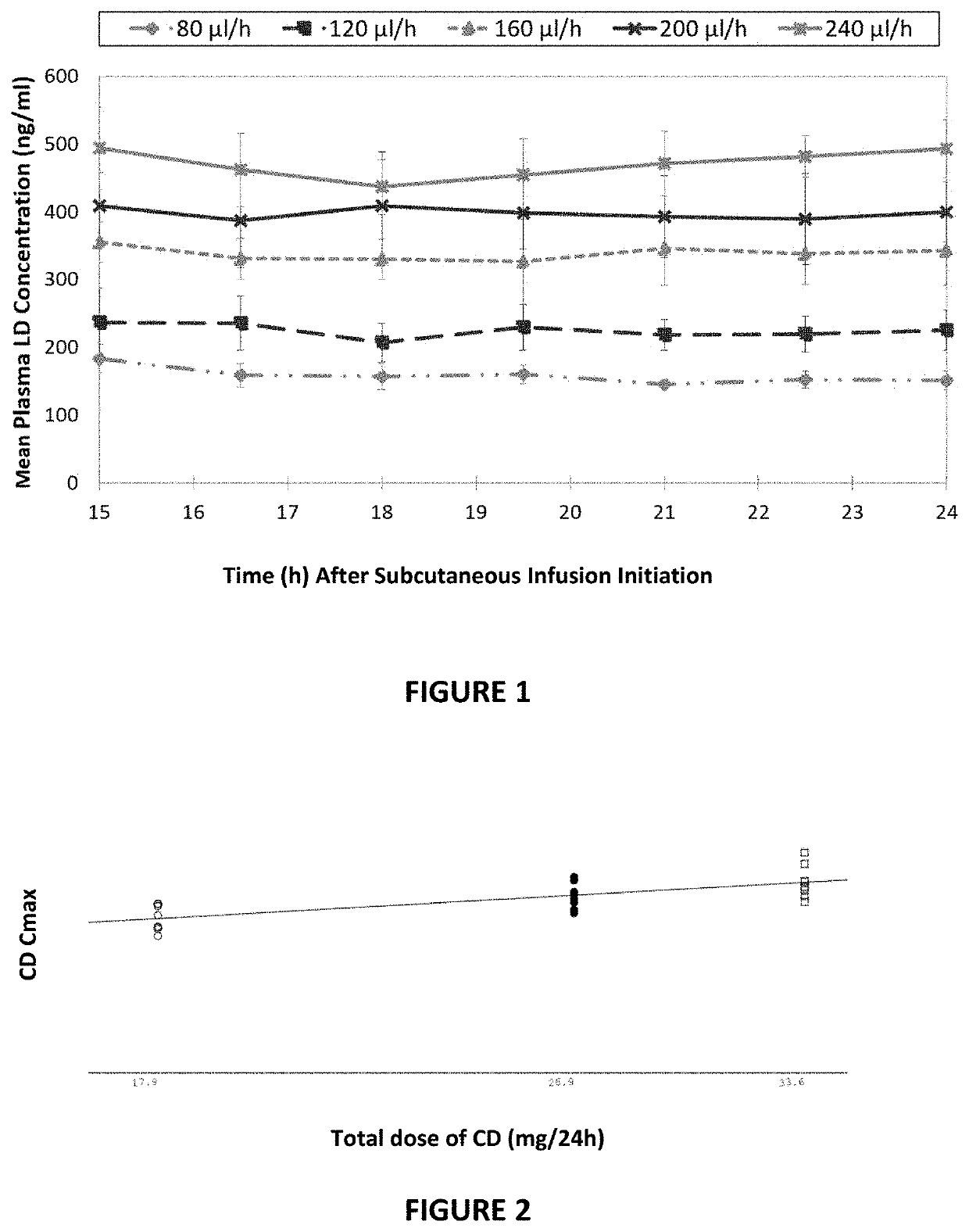Method for treatment of parkinson's disease
a parkinson's disease and treatment method technology, applied in the field of parkinson's disease treatment, can solve the problems of complicated long-term therapy and stimulation of pulsatile dopaminergi
- Summary
- Abstract
- Description
- Claims
- Application Information
AI Technical Summary
Benefits of technology
Problems solved by technology
Method used
Image
Examples
example 1
Synergism
[0223]A test was run in order to assess the plasma exposure of levodopa (LD) following the coadministration of LD and carbidopa (CD) in both subcutaneous (SC) and oral administrations. Accordingly, results obtained from a combined SC+oral administration were compared to results obtained from SC administration alone and from oral administration alone. An additive plasma exposure and PK profile was expected, i.e., it was expected that the SC+oral coadministration would provide results equal to the additive results of the SC and oral administrations, when each was administered separately.
Methods
[0224]16 healthy subjects (18-50 years) were treated in a crossover manner, i.e., sequentially, with a washout period of 6 days between the following two treatments:
[0225]Treatment A: A total dose of 180 / 22.5 mg LD / CD (formulation A) was administered by SC infusion over the course of 8 hours, at a steady infusion rate.
[0226]Treatment B: An immediate release (IR) tablet of 100 / 25 mg LD / C...
example 2
Dose Proportionality
Example 2a
[0238]Dose proportionality of LD and CD administered subcutaneously was demonstrated in a clinical trial (ND0612-001, a single dose, single-center, randomized, double-blind, placebo controlled, dose escalation study in healthy male subjects).
[0239]Subjects were administered with a composition comprising LD (6% w / w) / CD (1.4% w / w) by way of a 24 hour continuous infusion at varying infusion rates:[0240]Group 1: 80 μl / h[0241]Group 2: 120 μl / h[0242]Group 3: 160 μl / h[0243]Group 4: 200 μl / h[0244]Group 5: 240 μl / h
Several PK parameters were derived for both LD and CD in the dose proportionality assessment, including AUC (hr*ng / mL), Cmax (ng / mL), C15 (ng / mL), and C24 (ng / mL).
[0245]All analyses performed for all PK parameters studied demonstrated dose proportionality for both LD and CD. Reference is made to FIG. 1, which presents the mean plasma levodopa concentration of the five tested groups .vs. the time (in hours) after subcutaneous infusion initiation. As cle...
example 2b
[0246]In a separate clinical trial (ND0612-005a and ND0612-005b, open label design studies), the plasma carbidopa levels were tested in view of the subcutaneous administration of several carbidopa doses. Three formulations, comprising 60 mg / ml levodopa and (a) 7.5 mg / ml; (b) 6 mg / ml; or 4 mg / ml of carbidopa, were administered to three groups of subjects over the course of 24 hours, providing a total of 17.9 mg / 24 h carbidopa to each subject in the first group, 26.9 mg / 24 h carbidopa to each subject in the second group and 33.6 mg / 24 h carbidopa to each subject in the third group. The obtained carbidopa Cmax values showed clear dose proportionality (see FIG. 2).
PUM
| Property | Measurement | Unit |
|---|---|---|
| time | aaaaa | aaaaa |
| time | aaaaa | aaaaa |
| time | aaaaa | aaaaa |
Abstract
Description
Claims
Application Information
 Login to View More
Login to View More - R&D
- Intellectual Property
- Life Sciences
- Materials
- Tech Scout
- Unparalleled Data Quality
- Higher Quality Content
- 60% Fewer Hallucinations
Browse by: Latest US Patents, China's latest patents, Technical Efficacy Thesaurus, Application Domain, Technology Topic, Popular Technical Reports.
© 2025 PatSnap. All rights reserved.Legal|Privacy policy|Modern Slavery Act Transparency Statement|Sitemap|About US| Contact US: help@patsnap.com

